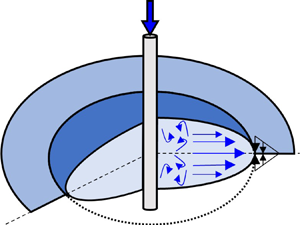No CrossRef data available.
Article contents
The influence of turbulence and inertia in radial fracture flow
Published online by Cambridge University Press: 14 February 2024
Abstract

Industrial applications of flow through fractures such as geothermal energy or hydraulic stimulation involve forcing large flow rates through small fractures, thereby inducing inertial fluid behaviours and turbulence. The most common fracture flow model, Poiseuille flow (the cubic law), is incapable of capturing these phenomena and thus the impact of inertial and turbulent forces in fracture flow has remained relatively unexplored. The GG22 flow model is a newly derived fracture flow model that is capable of capturing inertial, transient and turbulent forces. In this article, we apply the GG22 flow model to hydraulic stimulation of radial fractures for the first time to determine how these phenomena manifest. We show that inertia and turbulence only manifest near the wellbore (within 30 radii) and lead to changes in fracture shape and injection pressure but have little impact on tip behaviour. Turbulence increases wellbore pressure and aperture while inertia decreases wellbore pressure and aperture. The majority of the pressure loss along the fracture occurs near the wellbore and is captured by turbulence where entrance correction factors would otherwise be needed. Using water, turbulence is the dominant mechanism that causes departures from Poiseuille flow at high  $Re$. The solution departs immediately upon the manifestation of turbulence (
$Re$. The solution departs immediately upon the manifestation of turbulence ( $Re\geq 2\times 10^3$), while inertial effects manifest at higher flow rates (
$Re\geq 2\times 10^3$), while inertial effects manifest at higher flow rates ( $Re\geq 2\times 10^4$). Using slickwater, the opposite trend is observed: inertial effects manifest first (
$Re\geq 2\times 10^4$). Using slickwater, the opposite trend is observed: inertial effects manifest first ( $Re\geq 5\times 10^3$), while turbulent effects are delayed (
$Re\geq 5\times 10^3$), while turbulent effects are delayed ( $Re\geq 10^4$). In both cases, the threshold for departures from the Poiseuille flow solution are low and the differences are large.
$Re\geq 10^4$). In both cases, the threshold for departures from the Poiseuille flow solution are low and the differences are large.
JFM classification
- Type
- JFM Papers
- Information
- Copyright
- © The Author(s), 2024. Published by Cambridge University Press





